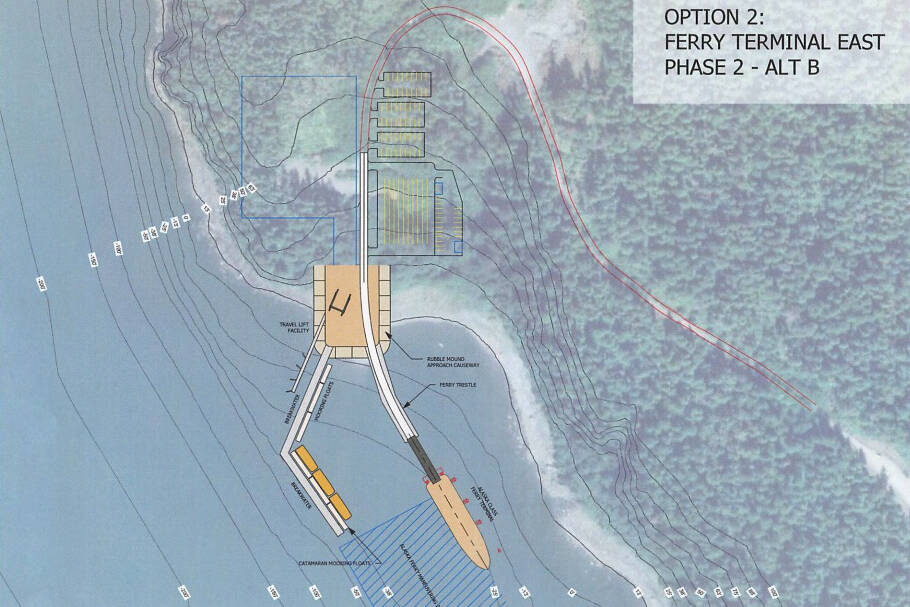The Alaska Department of Transportation and Public Facilities is seeking outside engineering and design services to determine whether it’s feasible to build a new ferry terminal facility in Juneau at Cascade Point, which could provide seasonal daily sailings to Haines and Skagway.
“This had been talked about for a long time,” said Shannon McCarthy, communication director for the DOT. “It’s one of our most popular routes, second from Bellingham, and that’s really what the push for this is.”
The state’s recent nationwide request for proposals for work — estimated to cost between $500,000 to $1 million — is currently active and interested parties have until Friday, Feb. 17 to respond to the request.
The proposal would extend Glacier Highway out to Cascade Point where it would meet a ferry terminal located on property that is currently owned by Goldbelt Inc. but would be leased to the state. The terminal is expected to accommodate the Tazlina and/or Hubbard and would provide seasonal daily sailing to Haines and Skagway from March through September. However, the DOT may consider the feasibility of year-round operations as well, according to the request.
Goldbelt President and CEO McHugh Pierre did not respond to calls seeking comment.
The project has been estimated in recent years to cost between $30 to 40 million, however, McCarthy said that could be subject to change depending on the findings from the engineering and design services.
McCarthy said the potential ferry terminal would work parallel with the DOT’s goals to make the Alaska Marine Highway system more sustainable and efficient for passengers, especially following the wave of the recent $285 million grant funding the Federal Transit Administration awarded to six projects for the Alaska Marine Highway System.
“We want to have a really robust Marine Highway system and work on making it as ecological and sustainable as we can,” she said.” We are going to continue to work on reinvesting in the Marine Highway system.”
It’s estimated the new terminal would take about 30 miles and two hours off of the current one-way Juneau to Haines and Skagway trip, which could reduce the ferry’s overall run time to 12 hours or less, according to a letter of intent signed by DOT and Goldbelt in April 2021 to discuss Cascade Point as the site for a ferry terminal.
“While that might not seem like a lot when you multiply, it really does save the public time and expenses,” McCarthy said.
The terminal is being considered to include an 800-1,000 square foot heated public waiting building with public restrooms along with approximately 20-35 spaces for passenger vehicle parking. Goldbelt also has the ability to choose to develop the area to provide commercial marine operations, including dedicated space for an AMHS facility.
There are two conceptual site plans included with the proposal, one of which was developed by DOT while the other was developed by Goldbelt. According to the proposal, the concept plans are only shared for informational purposes and are not accepted or preferred alternatives.
The RFP includes a timeline that outlines the preliminary design is expected to be completed by December 2023, followed by multiple reviews during 2024 before the physical construction is anticipated to start in March 2025 and extend through December 2026. The project is anticipated to be developed and designed as one project, but depending on budgetary or scheduling limitations it may be developed in a phased process.
McCarthy said the time frame for when the engineering and design services will begin depends on how many responses the DOT received for the proposal.
At a recent public event in Juneau, Gov. Mike Dunleavy, a Republican, was asked about his stance on a road linking Juneau to the Haines or beyond as well as a possible ferry terminal at Cascade Point, to which he said he is still reviewing with transportation department leaders.
“The idea is to get that road in,” he said at the recent event. “Cascade Point may be a part of it.”
Dunleavy spokesperson Shannon Mason said in an email that the proposal will allow the state to see if constructing a dock to operate a ferry out of Cascade Point is feasible.
“The Governor directed the DOT’s request for a ferry terminal because the primary motivation behind this proposal is to save time and money for the State and the public,” Mason said. “The ferry would allow for quick trips between Juneau, Haines, and Skagway, which is historically one of the most heavily traveled routes. As for the road, yes, it’s still an interest and is not preclusive.”
• Contact reporter Clarise Larson at clarise.larson@juneauempire.com or (651)-528-1807. Follow her on Twitter at @clariselarson.

